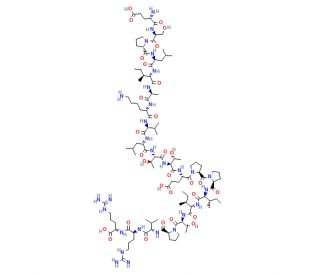

PLAP (CAS 137314-60-4)
QUICK LINKS
PLAP, or placental-like alkaline phosphatase, is an enzyme that belongs to the alkaline phosphatase family and shares structural and functional similarities with the placental alkaline phosphatase (PLAP) isozyme. It is predominantly expressed in germ cell tumors, particularly seminomas, making it a useful biomarker for diagnosing and monitoring these types of tumors. PLAP isoenzymes play a crucial role in various cellular processes by catalyzing the hydrolysis of phosphate esters at an alkaline pH, resulting in the release of inorganic phosphate and the corresponding alcohol or phenol. In research, PLAP has been extensively studied for its diagnostic and prognostic value in germ cell tumors. Additionally, researchers have investigated its expression patterns and regulatory mechanisms to gain insights into the molecular pathways involved in tumorigenesis. Furthermore, PLAP has been utilized as a model enzyme in biochemical and enzymological studies to understand its catalytic properties and substrate specificity. Its unique expression pattern and enzymatic activity make PLAP a valuable tool for both diagnostic and research purposes in the field of oncology and enzymology.
PLAP (CAS 137314-60-4) References
- Stimulation of Golgi membrane tubulation and retrograde trafficking to the ER by phospholipase A(2) activating protein (PLAP) peptide. | Polizotto, RS., et al. 1999. J Cell Biochem. 74: 670-83. PMID: 10440936
- Effects of phospholipase A(2) activating peptides upon GTP-binding protein-evoked adrenocorticotrophin secretion. | Guild, SB. 2001. Eur J Pharmacol. 424: 163-71. PMID: 11672558
- cPLA2 activator peptide, PLAP, increases arachidonic acid release and apoptosis of vascular smooth muscle cells. | Pilane, CM. and LaBelle, EF. 2004. J Cell Physiol. 198: 48-52. PMID: 14584043
- The cholesterol ester cycle regulates signalling complexes and synapse damage caused by amyloid-β. | West, E., et al. 2017. J Cell Sci. 130: 3050-3059. PMID: 28760925
- Cloning of a rat cDNA encoding a protein with high homology to mouse phospholipase A2-activating protein. | Wang, H., et al. 1995. Gene. 161: 237-41. PMID: 7665086
- Sequence similarity of phospholipase A2 activating protein and the G protein beta-subunits: a new concept of effector protein activation in signal transduction? | Peitsch, MC., et al. 1993. Trends Biochem Sci. 18: 292-3. PMID: 8236442
- Phospholipase A2-activating peptide-induced contraction of smooth muscle is mediated by protein kinase C--MAP kinase cascade. | Yamada, H. and Bitar, KN. 1995. Biochem Biophys Res Commun. 217: 203-10. PMID: 8526911
- Release of miniantibodies from E. coli cells into the supernatant at low and high cell densities. | Mörbe, JL. and Riesenberg, D. 1997. Microbiol Res. 152: 385-94. PMID: 9468660
Ordering Information
| Product Name | Catalog # | UNIT | Price | Qty | FAVORITES | |
PLAP, 100 µg | sc-200867 | 100 µg | $50.00 |
